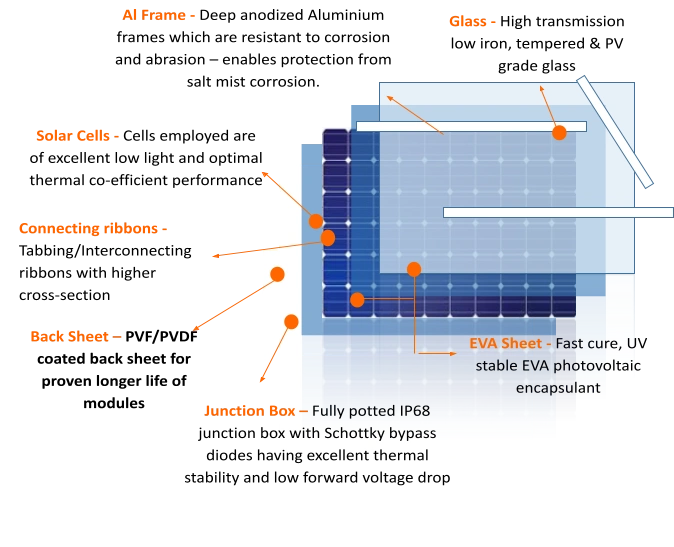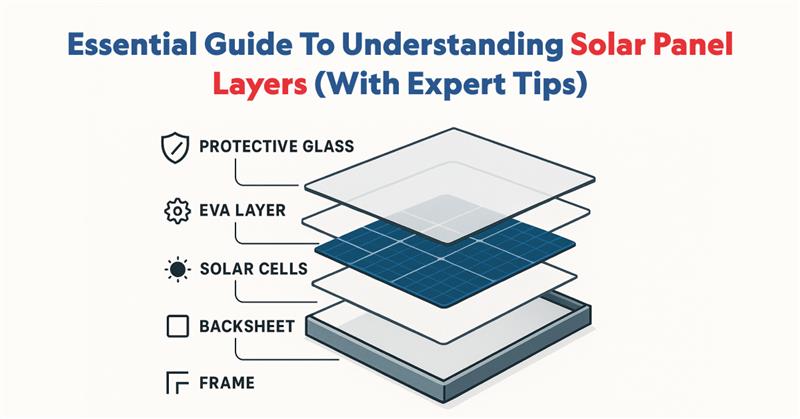Did you know that modern solar panel layers can achieve efficiency rates of up to 23%? That’s right – today’s monocrystalline silicon technology is not only becoming more efficient but also steadily declining in cost.
We often look at solar panels as single units, but it’s actually the sophisticated arrangement of solar panel layers that determines their performance and longevity. Each layer serves a crucial purpose, from capturing sunlight to protecting the sensitive components inside.
Different types of solar panel use these layers in unique ways to maximise energy production. For instance, bifacial panels can absorb solar energy from both sides, potentially enhancing power production by 30% just from backside reflexion. Additionally, innovations like half-cut solar cells divide traditional cells in half while using the same materials, improving overall panel efficiency.
In this comprehensive guide, we’ll take you through each layer of a solar panel, explain how various panel types utilise these layers differently, and provide expert advice on selecting and maintaining the right system for your needs. Whether you’re considering solar installation or simply curious about how these remarkable devices work, understanding what’s beneath the surface will help you make informed decisions.
What Each Layer in a Solar Panel Does?
Modern solar panels operate through a sophisticated arrangement of multiple layers, each performing specific functions to ensure efficiency, durability, and safety. Understanding these layers helps explain how sunlight transforms into usable electricity.

Top glass: Light entry and weather protection
The topmost layer of a solar panel consists of tempered, low iron-content glass. This specialised glass serves as the primary defence against environmental elements whilst allowing maximum sunlight to reach the cells beneath. With light transmittance reaching approximately 91.5% for regular tempered glass and up to 93.5% for specially coated glass, this layer ensures optimal solar energy absorption.
Essentially, the glass layer performs dual functions – it protects the internal components from chipping and weather damage whilst remaining highly transparent to allow photons to pass through. Furthermore, this layer must be impervious to water, have good impact resistance, and remain stable under prolonged UV exposure. The glass is designed to be “self-cleaning,” allowing rain to wash away dust and dirt that might otherwise reduce efficiency.
Encapsulant: Holding cells in place
Beneath the glass lies the encapsulant layer, typically made of ethylene vinyl acetate (EVA). This transparent polymer serves as an adhesive that bonds the solar cells to both the top glass and rear surface. The encapsulant creates a protective seal around the cells, preventing moisture ingress whilst providing mechanical support.
The encapsulant must withstand environmental stressors and maintain long-term stability, ideally for over two decades. Moreover, it must allow maximum sunlight penetration into the solar cells by minimising reflexion and refraction. During panel manufacturing, EVA sheets are inserted between the solar cells and surrounding layers, then heated to 150°C to polymerize and bond the module together.
Solar cells: Energy generation
Solar cells represent the heart of the panel, converting light into electricity through the photoelectric effect. These cells are typically arranged in a grid-like pattern, with modern panels containing either 60 or 72 cells assembled together. Each individual cell is a small square or rectangle connected by silver strips that conduct electricity to a central location.
The cells themselves are sandwiched between semiconducting materials like silicon. When photons from sunlight strike these materials, they energise the different electronic properties of each layer, creating an electric field. This process generates the current needed to produce electricity. The cells also receive a metal backing to enhance conductivity.
Backsheet: Moisture and UV protection
The backsheet forms the outermost rear layer of the solar panel, serving as the first line of defence for solar cells. This layer plays a critical role in protecting the panel from varying environmental conditions throughout its lifetime. High-quality backsheets must balance three critical properties: weatherability, mechanical strength, and adhesion.
Primarily, the backsheet shields against moisture-related damage, including corrosion of electrical connections, insulation degradation, and risk of short circuits. Additionally, it protects against potentially harmful UV radiation that can cause semiconductor materials within the solar cells to degrade. Backsheets also manage temperature-related stress, acting as insulators that safeguard the system against thermal extremes.
Junction box and wiring: Power output
The junction box is attached to the back of the solar panel with silicon adhesive. This crucial enclosure wires together the electrical connectors and serves as the output interface for the panel. Through cables with MC4/MC5 connectors, the junction box makes it easy to connect the panel to the larger solar array.
Most photovoltaic junction boxes contain diodes that keep power flowing in one direction and prevent electricity from feeding back into the panels when there’s no sunshine. A quality junction box carries an IP rating of 67, making it completely watertight. This component regulates heat and offers reliable long-term safety, ensuring the solar panel operates efficiently and securely.
How Panel Types Use Layers Differently
The structure of solar panel layers varies significantly across different panel technologies, affecting everything from efficiency to application versatility. Each panel type employs a unique layer configuration to harness solar energy based on its design philosophy.
Monocrystalline and polycrystalline layer setups
The difference between monocrystalline and polycrystalline panels begins at the cellular level. Monocrystalline panels feature cells made from single silicon crystals, giving them their characteristic black appearance with rounded edges.
Consequently, they achieve higher efficiency rates approaching 23%. Polycrystalline panels, meanwhile, contain cells made from multiple silicon fragments melded together during manufacturing, creating their distinctive blue-hued cells with straight edges.
Both panel types maintain similar layer structures—glass top, encapsulant, silicon cells, backsheet—yet the quality and arrangement of these layers differ subtly. Monocrystalline panels typically use higher-grade materials throughout their construction, which contributes to their premium price point (approximately 20% higher than polycrystalline).
Notably, temperature affects these panels differently. Though both suffer efficiency drops when heated, monocrystalline panels demonstrate greater resistance to heat-related performance losses. This difference stems partly from the purity of silicon used in their construction.
Thin-film panels: Fewer layers, more flexibility
Unlike their crystalline counterparts, thin-film panels employ a fundamentally different layer structure. Instead of using wafer-like cells, thin-film technology deposits a thin layer of photovoltaic material onto a substrate such as glass, plastic, or metal. This production method results in panels that are just a few nanometres to microns thick—significantly thinner than conventional 200μm crystalline panels.
The simplified layer structure gives thin-film panels distinct advantages, particularly their lightweight and flexible nature. Common thin-film materials include cadmium telluride (CdTe), copper indium gallium selenide (CIGS), and amorphous silicon (a-Si). Each material creates a different “type” of panel with unique properties.
CIGS panels, for instance, demonstrate promising performance on flexible substrates, making them excellent candidates for bendable solar applications. Furthermore, thin-film panels perform better in low light and high-temperature conditions compared to crystalline panels.
Bifacial panels: Transparent backsheets and dual glass
Bifacial technology represents a significant departure from traditional solar panel design through its ability to generate power from both sides. These panels typically employ either a dual-glass configuration or a transparent backsheet, allowing light to enter from the rear.
The dual-glass structure sandwiches solar cells between two glass sheets, typically using 2mm glass instead of the standard 3.2mm front glass with opaque polymer backsheet. This configuration offers enhanced durability and longevity, with some manufacturers extending warranties to 30 years compared to the standard 25 years for monofacial panels.
Alternatively, some bifacial panels use transparent backsheets rather than rear glass. These polymer-based backsheets maintain the same weight as standard modules whilst still allowing light to pass through. They offer better heat dissipation, potentially reducing cell operating temperature by 5-10°C and thereby improving efficiency.
Under optimal conditions, bifacial panels can generate up to 30% additional energy compared to traditional panels through their rear-side energy capture. However, this advantage depends heavily on installation conditions, with ground-mounted systems on reflective surfaces yielding the greatest benefits.
Key Takeaways
Understanding solar panel layers is crucial for making informed decisions about renewable energy investments and maximising system performance over decades of use.
• Each layer serves a specific purpose: tempered glass protects whilst allowing 93.5% light transmission, EVA encapsulant bonds components, and quality backsheets determine 25-30 year lifespan.
• Panel types use layers differently – monocrystalline achieves 23% efficiency in compact designs, whilst bifacial panels generate 30% more energy through transparent rear layers.
• Modern innovations like PERC technology boost efficiency by 12%, whilst half-cut cells reduce resistance losses and improve shade tolerance by creating six independent strings.
• Choose panels based on space constraints, durability needs, and budget – premium backsheets cost more initially but extend system life dramatically in harsh environments.
• Regular maintenance prevents costly failures – inspect for delamination bubbles, clean panels every two years, and replace when performance drops exceed 20% of original specifications.
The sophisticated engineering behind solar panels transforms simple sunlight into decades of clean electricity, making understanding these layers essential for maximising your renewable energy investment.
Innovations in Layer Technology
Recent advancements in solar technology have moved beyond basic panel structures to enhance efficiency through innovative layer modifications. These improvements tackle common limitations in traditional designs, pushing the boundaries of energy generation capability.
PERC: Rear layer passivation
Passivated Emitter and Rear Cell (PERC) technology represents a significant breakthrough in solar panel design. Developed at the University of New South Wales in 1983 and officially documented in 1989, PERC introduced a novel approach to layer arrangement. The innovation adds a dielectric passivation layer to the rear of the solar cell, creating a reflective surface that gives light a second chance to be absorbed.
This additional layer serves multiple purposes simultaneously. Firstly, it reflects unused light back across the cell junctions, generating more energy. Secondly, it reduces rear recombination, a common efficiency drain in standard panels. Thirdly, it prevents longer wavelengths from becoming heat that would otherwise impair cell performance.
The results speak for themselves—PERC technology has boosted efficiency by up to 12% compared to traditional silicon counterparts. Through steady refinement, PERC has become the industry standard, accounting for approximately 90% of global solar cell manufacturing output in 2022.
Shingled cells: Overlapping for better coverage
Shingled cell technology employs a fundamentally different approach to cell arrangement. Standard cells are laser-cut into 5-6 narrow strips, then overlapped like roof tiles with the rear busbar of one slice placed over the busbar of the next. This clever arrangement completely eliminates the need for interconnecting ribbons.
The benefits extend beyond aesthetics, although the clean, seamless appearance makes shingled panels particularly attractive for visible installations. Since interconnection happens through physical contact via electrically conductive adhesive, more of the panel surface actively captures sunlight.
Furthermore, the smaller area of individual slices reduces current flow through the module. Since resistive power loss scales with current, this configuration significantly decreases resistance losses. An additional advantage is that shingled panels can be wired in parallel rather than series, improving shade tolerance dramatically—outdoor testing showed 37-45% better performance in shaded conditions.
Half-cut cells: Reduced resistance and heat
Half-cut solar cell technology takes a straightforward approach: divide standard cells into two equal parts. This seemingly simple modification yields remarkable improvements in performance. By cutting cells in half, the current within each cell is likewise halved, which reduces resistive losses and improves overall efficiency.
The innovation extends beyond mere cell division. Half-cut panels employ a unique wiring system that transforms how electricity flows through the panel.
Traditional panels use a 3-string series wiring method, where shading on one cell affects an entire row—knocking out one-third of the panel’s power. In contrast, half-cut panels utilise a 6-string configuration, so shading affects only one-sixth of production.
This design creates effectively two independent modules within a single panel—if the top section experiences shading, the bottom continues generating electricity unimpeded.
Along with improved shade tolerance, half-cut cells manage heat more effectively. Since each smaller cell generates less heat, hotspots are distributed across more cells, minimising potential damage from thermal stress.
Choosing the Right Panel Based on Layer Design
Selecting solar panels requires balancing multiple factors related to their layer design. With numerous options available, understanding how layer configurations affect real-world performance becomes crucial for making informed decisions.
Space constraints and layer efficiency
When dealing with limited installation space, panel efficiency becomes the primary consideration. Monocrystalline panels offer superior space utilisation with efficiency rates approaching 23%, generating more power per square metre than other technologies. For extremely restricted areas, PERC technology provides additional efficiency gains through improved rear layer passivation.
Crucially, the physical size differences between panel types directly impact installation options. Monocrystalline panels are typically smaller than their polycrystalline counterparts yet produce equivalent power outputs.
Hence, for rooftops with irregular shapes or limited surface area, these space-efficient panels justify their premium price despite being approximately 20% more expensive.
Durability needs and backsheet quality
The backsheet layer significantly determines a panel’s lifespan, yet remains one of the most overlooked components. Double fluoropolymer backsheets (TPT or KPK) provide exceptional protection in harsh environments, offering 30-40 years of reliable service. Furthermore, these premium options resist UV degradation, moisture intrusion, and chemical exposure—essential considerations for coastal or industrial installations.
For moderate climates, single-sided fluoropolymer backsheets (TPE or KPE) represent a sensible middle ground, typically lasting 25+ years whilst costing substantially less. Indeed, backsheet selection should prioritise local environmental conditions above all else, as premature backsheet failure can necessitate complete system replacement.
Budget vs performance trade-offs
Beyond initial purchase price, long-term value depends on balancing upfront costs against lifetime energy production. Polycrystalline panels cost approximately AUD 1.38 to AUD 1.53 per watt compared to AUD 1.53 – AUD 2.29 for monocrystalline options. Nevertheless, their lower efficiency means more panels (plus additional mounting hardware) may be required to achieve equivalent output.
Importantly, panel durability directly affects return on investment. Premium backsheets increase initial costs yet extend system lifespan dramatically. Equally, bifacial panels command higher prices but may generate up to 30% additional energy in ideal conditions through rear-side collection.
Considering warranty length provides another value indicator—premium panels typically offer 25-30 year warranties versus 15-20 years for budget options. Ultimately, assessing your specific space constraints, local climate conditions, and financial timeframe remains essential for selecting the optimal panel configuration.
Expert Advice on Maintenance and Longevity
Regular maintenance checks are vital for preserving your solar panel investment, as environmental exposure gradually affects each layer’s performance. With proper care, panels can function effectively for 25-30 years.
Inspecting for delamination or yellowing
Delamination occurs when the encapsulant layer detaches from glass or backsheet components. Watch for these warning signs:
- Visible air bubbles, especially along frame edges
- Decreased system performance without obvious causes
- Low isolation resistance (below 24.5 MΩ for standard 60-cell modules)
Yellowing primarily affects the ethylene vinyl acetate (EVA) encapsulant, causing visible discoloration from clear to yellow or brown. This chemical deterioration releases acetic acid, potentially reducing panel efficiency by 9-50% whilst accelerating corrosion throughout the system.
Cleaning tips for glass and frame
Most panels self-clean with rainfall if installed at a 10-degree tilt. Nevertheless, professional cleaning every 2 years is recommended. For those considering DIY cleaning:
- Clean during early morning or late afternoon to prevent thermal shock
- Use soft brushes or sponges with warm water
- Avoid harsh chemicals, high-pressure washers, and abrasive tools
When to replace panels based on layer wear
Consider replacement under these circumstances:
- Physical deterioration with cracks, chips or severe discoloration
- Performance drops exceeding 20% from original specifications
- Backsheet damage showing cracking or peeling
- Significant power loss despite cleaning and repairs
Conclusion
Understanding solar panel layers proves essential for anyone considering renewable energy adoption. Each component works together harmoniously – from the protective glass top to the durable backsheet – creating a sophisticated system that converts sunlight into usable electricity.
Though often overlooked, the differences between panel types significantly impact performance and suitability for specific installations.
Monocrystalline panels excel in efficiency but cost more, while thin-film options offer flexibility for unique applications. Bifacial panels capture light from both sides, potentially increasing energy production by 30% under ideal conditions.
Recent innovations such as PERC technology, shingled cells, and half-cut designs have pushed efficiency boundaries even further. These advancements make solar energy more accessible and effective than ever before, with modern panels achieving efficiency rates up to 23%.
When selecting solar panels, you must consider your unique circumstances – available space, local climate, budget constraints, and long-term goals. Premium backsheets might increase initial costs but extend system lifespan dramatically, offering better value over time.
Regular maintenance checks remain vital for preserving your investment. Watch for signs of delamination or yellowing, clean panels appropriately, and know when replacement becomes necessary. With proper care, solar panels function effectively for 25-30 years.
Solar technology continues evolving rapidly, yet understanding what lies beneath the surface empowers you to make informed decisions. This knowledge helps maximise energy production, extend system lifespan, and ultimately achieve greater returns on your renewable energy investment.
FAQs
Q1. How do solar panel layers work together to generate electricity?
Solar panel layers work in harmony to convert sunlight into usable electricity. The top glass layer allows sunlight to enter while protecting the internal components. The encapsulant holds the solar cells in place, which generate electricity when struck by photons. The backsheet provides moisture and UV protection, while the junction box and wiring manage power output.
Q2. What are the main differences between monocrystalline and polycrystalline solar panels?
Monocrystalline panels are made from single silicon crystals, offering higher efficiency (up to 23%) and better heat resistance. They have a black appearance with rounded edges. Polycrystalline panels use multiple silicon fragments, resulting in a blue hue with straight edges. They’re less efficient but more affordable, typically costing about 20% less than monocrystalline panels.
Q3. How do bifacial solar panels differ from traditional panels?
Bifacial panels can generate power from both sides, potentially increasing energy production by up to 30%. They use either a dual-glass configuration or a transparent backsheet, allowing light to enter from the rear. This design offers enhanced durability and longevity, with some manufacturers extending warranties to 30 years compared to the standard 25 years for traditional panels.
Q4. What are some recent innovations in solar panel technology?
Recent innovations include PERC (Passivated Emitter and Rear Cell) technology, which adds a reflective layer to the rear of the cell, boosting efficiency by up to 12%. Shingled cells overlap like roof tiles, eliminating the need for interconnecting ribbons and improving shade tolerance. Half-cut cell technology reduces resistance and heat by dividing standard cells into two parts, enhancing overall panel performance.
Q5. How often should solar panels be cleaned and maintained?
Most solar panels are self-cleaning if installed at a 10-degree tilt, but professional cleaning every 2 years is recommended. For DIY cleaning, use soft brushes or sponges with warm water during early morning or late evening to prevent thermal shock.
Avoid harsh chemicals and high-pressure washers. Regular inspections for delamination, yellowing, or significant performance drops are crucial for maintaining panel efficiency and longevity.





